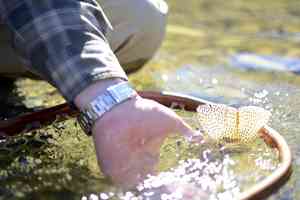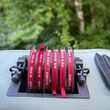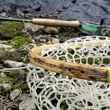I’ve been a proponent of rubber-soled boots since they first became available, having eagerly tossed my felt-soled boots into a corner in the basement where they’ve remained ever since. Whether or not felt soles conclusively play a role in transporting river-destroying pests like didymo and whirling disease was always of less interest to me than the common sense likelihood that they do, and so giving them up was easy.
The idea of “giving up” a pair of boot soles may no longer resound with all fishermen. Rubber-soled wading boots have been a mainstay in the industry for long enough now that many anglers may lack experience with felt-soled boots entirely. Those anglers, however, have almost certainly heard or read rants about the superior grip provided by felt soles -- rants which often dismiss the importance of retiring felt in the process.
Let’s be clear: anyone who tells you that rubber soles grip as well as felt, even when studded, is lying to you.
But so what? The health of the rivers we fish, the places we recreate, should be held paramount above all.
And it's not as if studded, rubber-soled boots represent a health hazard. Sure, they don’t grip river rocks as well as felt, but they provide more-than-adequate grip and traction and outperform felt boots considerably on the riverbank, on the trail and on ice and snow, where many of us spend just as much of our time during the course of a day of fishing.
Still, many anglers have been unwilling to relinquish the superior river traction of felt. Brands which retired felt from their lineups have brought it back due to angler demand, driven by the argument that even the most superior rubber-soled boots with the best and most well-placed studs still don’t provide the grip that felt boots provide. It’s an argument that, unfortunately, has been hard to refute.
Over the last few years, however, Patagonia has been seeking to turn that argument on its ear through its introduction of rubber-soled boots featuring aluminum bars instead of studs -- a design which has since shown up in models from other boot makers as well. Aluminum as a means of gripping rocks isn’t anything new, but has been largely ignored over the years by the fishing world. Unlike hardened steel, which most studs are made of, aluminum doesn’t grip by trying to stab its way into every surface it encounters. Aluminum, a soft and highly malleable metal, bends and molds with every step, conforming to rock surfaces while still being hard enough to bite through algae and aquatic vegetation.

With their latest iteration of their patent-pending aluminum bar technology, the Patagonia Foot Tractor wading boot, Patagonia may very well have produced a boot that will allow those still clinging to their old felt boots to let go without sacrificing anything.
What Works
Traction
Since we’ve been blathering on about traction and grip, it makes sense to tackle that first. Put simply, the aluminum bars that span the width of the Foot Tractor wading boots provide traction that is equal to and perhaps superior to felt.
The aluminum does exactly what it is purported to do, molding to and gripping rocks in what can best be described as a very “sticky” fashion. Anglers who have never waded in felt-soled boots won’t truly know what “sticky” means, but felt aficionados certainly will.
Slime is handled better than they are by either studded rubber boots or felt, with the edges of the aluminum bars slicing through algae and so forth to find purchase on the rocks underneath.
The zig-zag design of the bars on the Foot Tractor represent a real improvement on all rock surfaces, but particularly when gripping larger, flatter rocks.
It is honestly hard to say enough about the grip, stability and traction provided by the aluminum-clad soles of the Foot Tractor boots. During a day spent on the river you’ll more likely remark at the rare times during which you don’t get a good foot grab on the riverbed, rather than those when you do.
Fit
I initially found the heel-to-toe fit of the Foot Tractor boot (size 13) a bit constraining, with a bit of heel pressure (none in the toe) in my larger right foot, but concerns in this regard were quickly set aside after the boot wore in after a day or two of use.
Overall, the Foot Tractor boots feature a roomy fit thanks to their large foot box which offers plenty of room for stuffing in waders packed with several layers of socks and not feeling the least bit constrained.
Despite the roominess, the Clarino® synthetic leather upper can be cinched down considerably by the boot’s laces, allowing you to produce a very conforming fit that won’t leave you sloshing around in the boot. As with most wading boots, though, you’ll likely want to stop and adjust this after the boot has been marinating in the river for a bit.
Roominess is a boon to many anglers, and a result these boots may indeed be a steelheader’s dream boot, but it’s not always a positive. More on this later.
Comfort
Cozy isn’t normally a word that wading boots conjures up in the minds of anglers, but that may be changing with the Foot Tractor boot. These are quite possibly the most comfortable wading boots I’ve ever worn, thanks certainly to the aforementioned roominess and a bevy of interior cushioning.
Weight
For a pair of bulky-looking boots with large pieces of metal bolted to the bottom of them, the Patagonia Foot Tractor boots wear surprisingly light. They wear light because, according to the scale, they’re not particularly so.
I had to check with Patagonia to verify that their specifications on the boot were correct because, while the Foot Tractor boots weigh in near or above most “flagship” boots from other brands, they simply don’t feel like it.
During long days of rock hopping and streamside scrambling, you’ll remark about the comfort of the Foot Tractor boots, not their heft and bulk. It’s not clear how they’ve done it, but Patagonia has managed to make a sturdy, substantial boot that wears very light and is reasonably nimble on the trail.
Trail Readiness
Unlike Patagonia’s previous aluminum-barred offering and current offerings from other wading boot makers, which essentially featured a flat sole with thick aluminum slapped on the bottom, the bars on the Foot Tractor boot are partially recessed, providing a far superior integration with the sole.
The result is a boot that performs exceedingly better out of the water and even hikes well on the trail. With other aluminum-barred models, you get the sensation that you’re walking solely on the aluminum bars when out of the water. That isn’t the case with the Foot Tractor, which hikes much more like a true boot.
Replaceable Bars
Like previous designs, the bars on the Foot Tractor boots are replaceable. Unlike previous bars, however, the new design features counter-sunk screws which avoid the problems of bars coming loose from earlier versions. Replacing the bars on both boots isn't cheap -- it'll run you $49. That's around twice what a brand-name pair of studs will cost you. But, you typically need two packs of studs to provide proper coverage and studs commonly pull out and get lost. The aluminum bars last far longer than studs and won't pull out.
What Doesn’t
Fit
That roominess that’s touted above? As noted, not always a good thing, particularly if you’re looking to use your wading boots both with waders and when wet wading. Despite the fact that the uppers on the Foot Tractor do cinch down surprisingly well, the foot box on these boots is simply too roomy for them to be comfortable wet waders. Even with neoprene booties and thick socks, there’s still too much play in the Foot Tractor boots. At least for me. I’ve had numerous folks disagree with me on this front, so this likely comes down to the shape and size of your foot. So, if you’re looking for the Foot Tractor to be your year-round boot, make sure to size it for both scenarios before taking the plunge.
In Patagonia’s defense, the reality here is that no one is making a true 4-season boot. If you’re looking for a dedicated wet-wading boot, you’ll be disappointed, because they sadly still don’t exist. For now, your best bet is the Simms Vapor Boot.
Grip on Bedrock
The Foot Tractor provides superior grip on virtually every single rock surface we encountered, save one: bedrock. If you commonly fish rivers with table-flat bedrock streambeds -- like New York’s Sandy -- this is not your boot. As good as the aluminum bars are at molding to the rock surfaces they meet, they need a surface to mold to. Flat bedrock doesn’t offer this, and can often leave you skating down the river. Thankfully, these types of streambeds are fairly rare.
Final Word
In many ways, the Patagonia Foot Tractor wading boots are the best wading boots I’ve ever worn. They’ve carried me confidently on disparate rivers throughout the lower 48, Canada, Alaska and Argentina, with streambanks and beds that run the gamut. On virtually every occasion, they’ve provided superior traction and stability and frequently called me to remark on their comfort and durability.
With the Foot Tractor, Patagonia has not simply refined the design of previous offerings such as the version of its Rock Grip boots that featured aluminum bars. Instead, it has learned from the successes and failures of those earlier designs and produced an all-new boot that is a much more well-rounded, full featured boot than its predecessors.
Yes, the Foot Tractor boot has its tradeoffs but, until someone makes the perfect boot, this will be the case with any model you choose. If we are ever to see the perfect wading boot, given the advancements evident in the Foot Tractor -- it may just come from Patagonia.






























Comments
Damon replied on Permalink
I've been fishing with this boot for about a year now, and it's the best boot I've worn since I had to retire my Simms felt soled boots years ago. Even when I fish places where felt is still legal, I go for these over my old Simms felt boots. With Patagonia's awesome customer service, I also know that they'll take good care of me if any problems develop.
Anonymous replied on Permalink
how do the aluminum bar do in a boat? would they cause damage like studs?
Chad Shmukler replied on Permalink
Depends on a the boat. In a hard-bottomed drift boat, they'd be fine and I suspect would do little if anything noticeable to the boat floor.
Don K replied on Permalink
I've been wearing mine for over a year and agree they provide incredible traction in the stream. My experience on land is not the same. When fishing in central PA necessitates a walk/hike they are underwhelming. Their roomy design makes them cumbersome on land. I've tripped on lots of roots and branches wearing them. And with the insole so flat, my feet hurt from any technical hikes. So if I can park in front of the spot I'm fishing they are great. Otherwise I liked the Simms Guide Boot
Pages